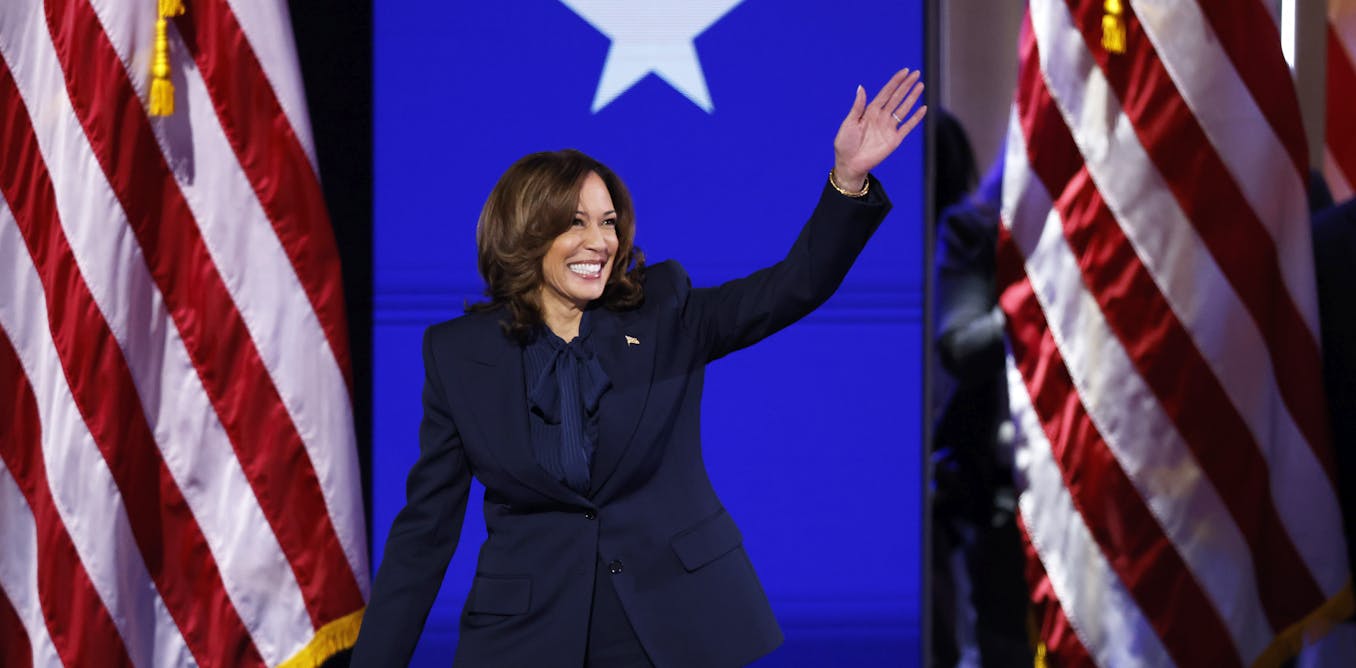The United States presidential election will be held on November 5. In analyst Nate Silver’s aggregate of national polls, Democrat Kamala Harris leads Republican Donald Trump by 48.8–44.8. In my previous US politics article last Monday, Harris led Trump by 47.1–44.6.
Joe Biden’s final position before his withdrawal as Democratic candidate on July 21 was a national poll deficit against Trump of 45.2–41.2. By the election, Biden will be almost 82, Trump is now 78 and Harris will be 60.
Robert F. Kennedy Jr withdrew from the presidential contest in swing states on Friday US time and endorsed Trump. Silver said Kennedy initially had 10–11% support in a three-way matchup with Trump and Biden, but this had faded to about 8% at Biden’s withdrawal.
When Harris replaced Biden, this reduced the number of voters who disliked both major party candidates, and Kennedy fell to about 4%.
Kennedy’s withdrawal will probably assist Trump a little, as Kennedy’s ideological positions were closer to Trump’s, and Kennedy endorsed Trump. But Kennedy only had 4% before his withdrawal, so there won’t be a large impact. There have not yet been polls conducted since Kennedy’s withdrawal or the Democratic National Convention, which ran from Monday to Thursday this week.
The US president isn’t elected by the national popular vote, but by the Electoral College, in which each state receives electoral votes equal to its federal House seats (population based) and senators (always two). Almost all states award their electoral votes as winner takes all, and it takes 270 electoral votes to win (out of 538 total).
Silver’s numbers have been adjusted for Kennedy’s withdrawal. They reflect polls conducted during the convention that gave Harris a boost before her address on Thursday. As Silver’s model was factoring in a convention bounce, Harris’ win probability is little changed at 53.2% (53.5% last Monday).
Convention bounces usually peak in the week following a convention, then fade slowly. Polls conducted in the next week will show the impact of the Democratic convention and Kennedy’s withdrawal.
I wrote last Monday that if Harris leads by four to five points nationally after the convention, her win probability in Silver’s model will not change much. If she leads by six points, her win probability will increase, and if she only leads by two points her win probability will decrease.
Labor thumped at NT election
At Saturday’s Northern Territory election, the ABC is giving the Country Liberal Party (CLP) 15 of the 25 seats, Labor four, independents two and there are four seats still undecided. Labor had governed in the NT since winning the 2016 election. In 2020, Labor won 14 of the 25 seats, the CLP eight, independents two and the Territory Alliance one.
NT-wide primary votes were 47.8% CLP (up 16.5% since the 2020 election), 29.5% Labor (down 10.0%), 8.3% Greens (up 4.0%) and 14.4% independents (up 3.7%). The Territory Alliance, which won 12.9% in 2020, did not contest this election. The ABC’s two-party preferred estimate is a CLP win by 57.1–42.9 over Labor, a 10.1% swing to the CLP since 2020.
Postal votes have not yet been counted, and these are likely to assist the CLP. In the four seats in doubt, the CLP is ahead and likely to win Casuarina. The electoral commission probably selected the wrong final two candidates in Fannie Bay and Johnston, and now needs to redo the preference count.
The Greens are likely to win Fannie Bay and an independent Johnston. If the Greens win Fannie Bay, it will be their first ever seat in the NT parliament.
In Nightcliff, we can’t yet determine whether the CLP or the Greens will make the final two. Labor easily beats the CLP, but we don’t know the outcome if the Greens are their final opponent, but Labor should win.
If the seats in doubt go as expected, the final outcome will be 16 CLP out of 25, five Labor, three independents and one Green. The Poll Bludger said the anti-Labor swings were particularly savage in northern Darwin, while Labor held up much better in the rural and Indigenous-heavy seats. Four of Labor’s five likely survivors are of Indigenous background.
In 2022 Labor defeated the federal Coalition government and in 2023 they defeated the NSW Coalition government. I believe this is the first defeat of a Labor government in Australia since Labor lost the 2018 South Australian election. The Queensland Labor government appears doomed at an election in October.
Federal polls: Freshwater steady at 51–49 to Coalition
A national Freshwater poll for The Financial Review, conducted August 16–18 from a sample of 1,061, gave the Coalition a 51–49 lead, unchanged from the July Freshwater poll. Primary votes were 41% Coalition (up one), 32% Labor (up one), 12% Greens (down one) and 15% for all Others.
Anthony Albanese’s net approval was up four points to -10, with 45% unfavourable and 35% favourable. Peter Dutton’s net approval was steady at -3. Albanese led Dutton as preferred PM by 45–41 (45–39 in July).
In better news for Labor, the Coalition’s lead over Labor on the cost of living was reduced from 12 points in July to seven, and their lead on managing the economy was reduced from 16 points to 13. The cost of living was rated one of the most important issues by 76%, far ahead of housing on 38%.
Morgan poll: 50.5–49.5 to Labor
A national Morgan poll, conducted August 12–18 from a sample of 1,698, gave Labor a 50.5–49.5 lead, a 0.5-point gain for Labor since the August 5–11 poll.
Primary votes were 38.5% Coalition (up 0.5), 30.5% Labor (up one), 13.5% Greens (down 0.5), 4% One Nation (down one), 8.5% independents (down one) and 5% others (up one).
The headline figure is based on respondent preferences. If 2022 election preference flows are used, Labor leads by an unchanged 51–49.



